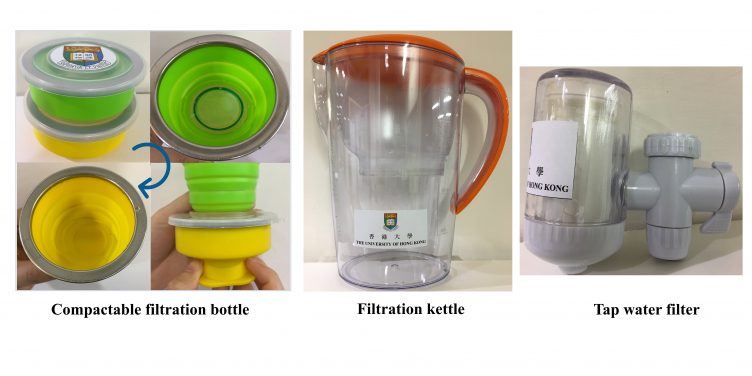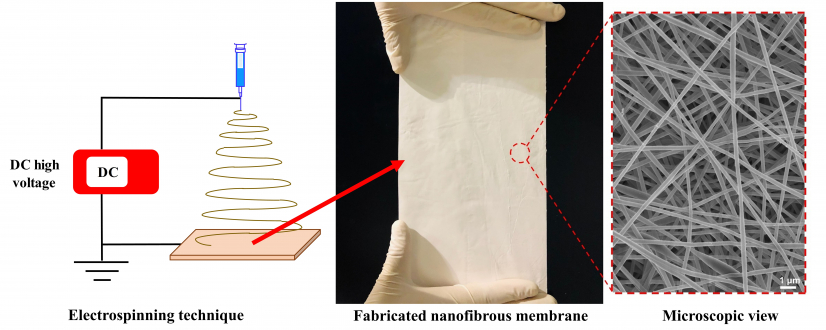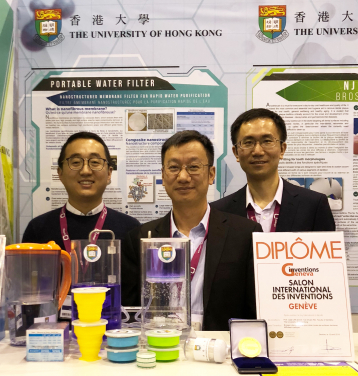Media
HKU scientists invent efficient nanofibrous membrane to filter heavy metals and bacteria
16 Jun 2019

Nanofibrous membrane product prototypes: compactable filtration bottle, filtration kettle and tap water filter.

(from left) The nanofibrous membrane is fabricated using an electro-spinning technique, the membrane, and its texture viewed under a scanning electron microscope.
Scientists at the University of Hong Kong (HKU) have invented an efficient and highly permeable nanofibrous membrane that can effectively filter various contaminants in water, particularly heavy metals and bacteria, making it valuable in disaster relief in addition to everyday use.
A research team led by Professor Tang Chuyang of the Department of Civil Engineering at HKU has found that the membrane can rapidly filter heavy metals such as lead (Pb), nickel (Ni), cadmium (Cd), and chromium (Cr) with larger than 99.9% efficiency while eliminating bacteria such as E. coli and B. subtilis. The membrane filter is easily operated via a gravity-driven filtration process and can be reused after being rinsed in vinegar.
The invention won a Gold Medal at the 47th International Exhibition of Inventions Geneva earlier this year. It already received a US and a Chinese patent with another US patent underway. Technology transfer, licensing and commercialisation are expected. The material will be promising to be used in household water filter and portable water filtration bottle. The project is funded by the Innovation and Technology Fund from the Hong Kong Government’s Innovation and Technology Commission.
Since 2014, the research team has been working on developing a highly-efficient membrane to rapidly filter contaminants and bacteria in water. The latest invented nanofibrous membrane is fabricated via an electro-spinning technique which utilises electric force to spray polymer solution onto nanofibers to stretch their diameter into 10s to 100s nanometer. Their different dimensions enable the nanofibers to deal with various target contaminants with diverse properties. These nanofibers are then weaved into a nanofibrous membrane.
The novel nanofibrous membrane offers an efficient, convenient and inexpensive solution to filter heavy metals and bacteria in water. After filtration with this membrane, the concentration of heavy metals in drinking water is significantly lower than the threshold set by the World Health Organization (WHO). It also performs much better than commercial water filters utilising activated carbon (table 1). In a feed lead solution of 50 μg/l (ppb) (WHO’s safe level for lead in drinking water is 10 μg/l (ppb) or less), the removal efficiency is over 99.9%. The same efficiency level is achieved with removal of nickel, commonly used in pipes and fittings, and other heavy metals such as cadmium and chromium. Bacteria such as E. coli and B. subtilis are almost totally removed in the process.
Other conventional water treatment methods for removing heavy metals such as reverse osmosis and distillation consume energy. This nanofibrous membrane does not require any electricity or energy input in its operation. It can be reused many times as contaminants trapped can be removed simply by rinsing the membrane in vinegar. Raw materials for the membrane are inexpensive. Hence the price of this nanofibrous membrane filter is expected to be 30 to 50% cheaper than similar products using carbon filters on the market.
Professor Tang said: “This nanofibrous membrane was designed with an initial motivation to address the critical need for clean and drinkable water in the aftermath of major natural disasters. After an earthquake or tsunami, there is often a lack of reliable source of clean water or electricity, so you need something practical for disaster relief. Our filter fits in very well: it delivers safe drinkable water in less than one minute. Simple and reliable, and no electricity is needed. It is compact and can easily fit into a pocket. The filter also received great interests and attentions from travellers and adventurers at the exhibition.”
Going forward, Professor Tang and his team are researching on expanding the nanofibrous membrane’s function to filter a wider range of contaminants and achieve rapid water purification.
Professor Tang is an internationally renowned researcher in membrane, and a leading inventor with multiple international patents. His research team focuses on the development of advanced membrane material for seawater desalination, water reuse, and energy recovery from salinity gradient in water. His invention of Aquaporin Inside Membranes (AIMs®) have been successfully commercialised and used in seawater desalination and forward osmosis.
For media enquiries, please contact Ms Melanie Wan, Senior Manager (Media) tel: 2859 2600 / email: melwkwan@hku.hk of the Communications and Public Affairs Office, HKU.


